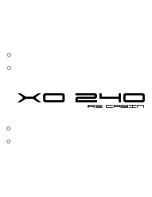
CHAPTER 3
PROPULSION SYSTEM
- 13 -
34z
The engine may seize if it is operated when seawater intake is restricted or if
load is applied without allowing the water temperature (engine) to warm up.
During the first 10 hours of operation, full load should only be applied for short periods. Never run
the engine for a long period at a constant RPM during this period. Higher oil consumption is
typical at this time, so carefully observe oil pressure and engine temperature, exhaust color and
check engine oil and coolant levels frequently... i.e. daily.
3.2 COOLING
Your engine passes seawater (raw
water) through two 3-WAY thru-
hulls located forward of the
engines, then thru raw water filters
(indicated above) then through
pumped through the impeller to a
heat exchanger where it cools the
engine’s coolant. This coolant is
then circulated through the engine
and returns to the heat exchanger.
For the engine to keep cool, it must
have an adequate supply of raw water and coolant.
Periodically check to be sure it’s clean and check the
coolant level by opening the caps on top of the engine.
Coolant should be close to the top. See EOM 55-127.
For details on what type of coolant to use, consult the
engine operator’s manual or the maintenance schedule
included in this manual. As the water and exhaust exit
out the back of the drives, it is not as easy to check
raw water flow. It is recommended to pay close
attention to water temperature (176°-194° F is normal
at cruising speed) at the outset.
Do not attempt to remove the coolant
cap of a hot engine.
The 3-WAY RAW WATER INTAKE THRU-HULL VALVES are tricky and counter-intuitive.
“Closed” is up, not “ON” as on most thru-hulls. Confusion here has led to a couple of burned out
impellers on 34z’s. “OPEN” for engine operation is when the handles are pushed down to PORT.
“EMERGENCY PUMP” or “FRESHWATER FLUSH” is when the handles are pushed down to
STARBOARD. To operate as an emergency pump, connect hose(s) into the top hose
connection. In fact, short lengths of hose(s) with a shut-off could be attached at all times.
3.3 LUBRICATION
Both the engine and drives use oil for lubrication. The transmission will tend to use less oil than
the engine, but both should be checked frequently. For the proper type of oils to use (which may
depend on the service area and conditions), see EOM 42-46.
For inspection procedures and maintenance schedule consult EOM 50-52 and 55-127.
The engine oil may be checked on the engines using dipsticks, at least ½ hour after running of
the engines to allow the oil to drain down from the upper part of the engine.
The drive lube reservoir is located at the upper aft port corner under the plastic engine cover.
Emergency
Pump or
FLUSH
to Starboard
OPEN
to Port
CLOSED
IF UP














































